
- Issue 16 Pages 1251-
- Issue 15 Pages 1165-
- Issue 14 Pages 1033-
- Issue 13 Pages 989-
- Issue 12 Pages 899-
- Issue 11 Pages 795-
- Issue 10 Pages 721-
- Issue 9 Pages 653-
- Issue 8 Pages 569-
- Issue 7 Pages 513-
- Issue 6 Pages 427-
- Issue 5 Pages 395-
- Issue 4 Pages 343-
- Issue 3 Pages 89-
- Issue 2 Pages 35-
- Issue 1 Pages 1-
- Issue 16 Pages 2157-
- Issue 15 Pages 1805-
- Issue 14 Pages 1613-
- Issue 13 Pages S1141-
- Issue 12 Pages S1037-
- Issue 11 Pages 1443-
- Issue 10 Pages 1273-
- Issue 9 Pages 1077-
- Issue 8 Pages 917-
- Issue 7 Pages 751-
- Issue 6 Pages 585-
- Issue 5 Pages S389-
- Issue 4 Pages S1-
- Issue 3 Pages 403-
- Issue 2 Pages 233-
- Issue 1 Pages 19-
- Issue 16 Pages 2153-
- Issue 15 Pages 1977-
- Issue 14 Pages 1813-
- Issue 13 Pages S1285-
- Issue 12 Pages S1043-
- Issue 11 Pages 1667-
- Issue 10 Pages 1481-
- Issue 9 Pages 1231-
- Issue 8 Pages 891-
- Issue 7 Pages 711-
- Issue 6 Pages 538-
- Issue 5 Pages S407-
- Issue 4 Pages S1-
- Issue 3 Pages 347-
- Issue 2 Pages 173-
- Issue 1 Pages 14-
- Issue 16 Pages 1837-
- Issue 15 Pages 1711-
- Issue 14 Pages 1569-
- Issue 13 Pages S1205-
- Issue 12 Pages S1034-
- Issue 11 Pages 1423-
- Issue 10 Pages 1269-
- Issue 9 Pages 1059-
- Issue 8 Pages 925-
- Issue 7 Pages 775-
- Issue 6 Pages 627-
- Issue 5 Pages S287-
- Issue 4 Pages S1-
- Issue 3 Pages 301-
- Issue 2 Pages 147-
- Issue 1 Pages 12-
- Issue 16 Pages 2179-
- Issue 15 Pages 1795-
- Issue 14 Pages 1631-
- Issue 13 Pages S1053-
- Issue 12 Pages S1023-
- Issue 11 Pages 1501-
- Issue 10 Pages 1315-
- Issue 9 Pages 987-
- Issue 8 Pages 767-
- Issue 7 Pages 621-
- Issue 6 Pages 473-
- Issue 5 Pages S305-
- Issue 4 Pages S1-
- Issue 3 Pages 299-
- Issue 2 Pages 151-
- Issue 1 Pages 16-
- Issue 16 Pages 1945-
- Issue 15 Pages 1699-
- Issue 14 Pages 1531-
- Issue 13 Pages S1055-
- Issue 12 Pages S1013-
- Issue 11 Pages 1367-
- Issue 10 Pages 1215-
- Issue 9 Pages 1087-
- Issue 8 Pages 887-
- Issue 7 Pages 721-
- Issue 6 Pages 507-
- Issue 5 Pages S317-
- Issue 4 Pages S1-
- Issue 3 Pages 343-
- Issue 2 Pages 187-
- Issue 1 Pages 17-
- Issue 16 Pages 2405-
- Issue 15 Pages 2067-
- Issue 14 Pages 1865-
- Issue 13 Pages 1675-
- Issue 12 Pages S1055-
- Issue 11 Pages S1015-
- Issue 10 Pages 1479-
- Issue 9 Pages 1129-
- Issue 8 Pages 895-
- Issue 7 Pages 711-
- Issue 6 Pages 545-
- Issue 5 Pages S325-
- Issue 4 Pages S1-
- Issue 3 Pages 369-
- Issue 2 Pages 193-
- Issue 1 Pages 16-
- Issue 16 Pages 2573-
- Issue 15 Pages 2261-
- Issue 14 Pages 2073-
- Issue 13 Pages S1111-
- Issue 12 Pages S1001-
- Issue 11 Pages 1867-
- Issue 10 Pages 1657-
- Issue 9 Pages 1409-
- Issue 8 Pages 1043-
- Issue 7 Pages 841-
- Issue 6 Pages 649-
- Issue 5 Pages S415-
- Issue 4 Pages S1-
- Issue 3 Pages 431-
- Issue 2 Pages 225-
- Issue 1 Pages 3-
- |<
- <
- 1
- >
- >|
-
2021Volume 107Issue 6 Pages Cover-
Published: June 01, 2021
Released on J-STAGE: May 31, 2021
JOURNAL OPEN ACCESSDownload PDF (668K) -
2021Volume 107Issue 6 Pages Contents-
Published: June 01, 2021
Released on J-STAGE: May 31, 2021
JOURNAL OPEN ACCESSDownload PDF (3479K) -
2021Volume 107Issue 6 Pages Editorial-
Published: June 01, 2021
Released on J-STAGE: May 31, 2021
JOURNAL OPEN ACCESSDownload PDF (205K)
-
Taichi Murakami2021Volume 107Issue 6 Pages 385
Published: 2021
Released on J-STAGE: May 31, 2021
JOURNAL OPEN ACCESS FULL-TEXT HTMLDownload PDF (295K) Full view HTML -
Takayuki Maeda, Yusho Yoshitake, Ko-ichiro Ohno, Kazuya Kunitomo2021Volume 107Issue 6 Pages 386-393
Published: 2021
Released on J-STAGE: May 31, 2021
JOURNAL OPEN ACCESS FULL-TEXT HTMLIn order to simplify the factor which affected on granulation properties of the iron ore, granulation experiment was conducted by using nuclei and fine iron ore having smooth surface. The effect of particle size of fine hematite iron ore on granulation properties and strength was investigated. The results obtained are follows:
(1) From the results of granulation experiment using single test sample Ore HF, HF’ and HF’’ having different particle sizes, the wet and dry strength of quasi-particle obtained by using single test sample did not depend on the quasi-particle size.
(2) When using mixing sample consisting of Ore HN used as nucleus ore and Ore HF, HF’ and HF’’ used as adherent fine ore, the wet and dry strength of quasi-particle bigger than 5 mm was almost the same level in the case of single test sample. On the other hand, the wet and dry strength of quasi-particle less than 5 mm was larger than that of single test sample.
(3) When the quasi-particle size using mixing sample was bigger than 5 mm, the compressive strength of quasi-particle depended on the compressive strength of adherent layer because the nucleus ore did not contact with each other. On the other hand, when the quasi-particle size was smaller than 5 mm, the compressive strength of quasi-particle was independent on the compressive strength of adherent layer because the nucleus ore contacted with each other.
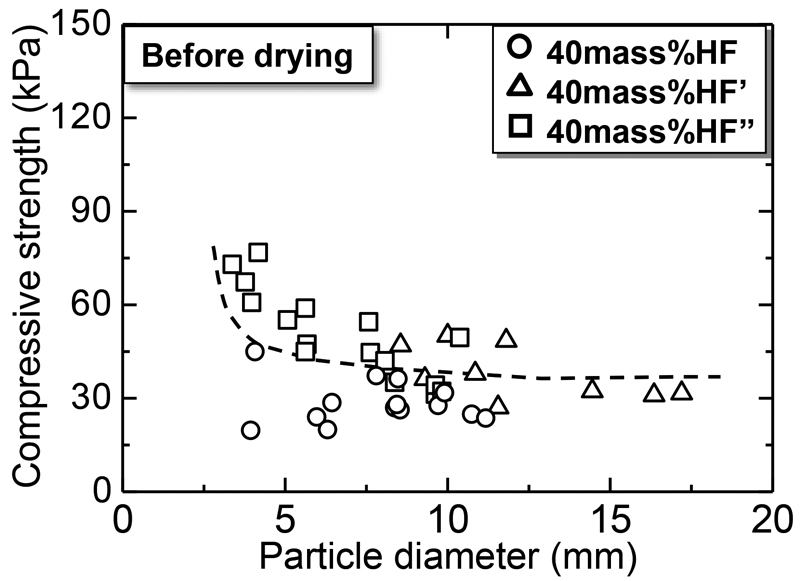 View full abstractDownload PDF (2028K) Full view HTML
View full abstractDownload PDF (2028K) Full view HTML -
Hideya Nakamura, Akio Kawata, Tomoya Baba, Shuji Ohsaki, Satoru Watano2021Volume 107Issue 6 Pages 394-402
Published: 2021
Released on J-STAGE: May 31, 2021
Advance online publication: December 04, 2020JOURNAL OPEN ACCESS FULL-TEXT HTMLThere is a great demand for understanding the layering granulation of coarse and fine iron ore particles. For the understanding, a numerical simulation can be powerful approach. We here proposed a numerical simulation method, by which the deposition of fine particles with water on the surface of a coarse particle can be simulated. In the proposed model, surface of a coarse particle was modeled as a flat surface. The fine particles and water droplets were then deposited on the flat surface with minimizing the surface energy of the liquid and potential energy of the particles, resulting in a bed of the deposited particles with water under the equilibrium state with considering the influence of the physicochemical properties of the particles and liquid. First, an experiment of the deposition of spherical polymer beads with water droplet on the flat polymer sheet was performed. The simulation results showed an agreement with the experimental result, demonstrating the validity of the proposed simulation method. Second, influences on the liquid amount and contact angle (i.e., wettability) of the particles were analyzed. The simulation results suggest that the smaller contact angle (good wettability) can result in more rigid bed with less ungranulated particles.
 View full abstractDownload PDF (2736K) Full view HTML
View full abstractDownload PDF (2736K) Full view HTML -
Kenta Takehara, Takahide Higuchi, Toshiyuki Hirosawa, Tetsuya Yamamoto2021Volume 107Issue 6 Pages 403-411
Published: 2021
Released on J-STAGE: May 31, 2021
JOURNAL OPEN ACCESS FULL-TEXT HTMLFor countermeasures of deterioration in iron ore, development of pretreatment technology for high quality iron ore fine is critical issue in the sintering process. However with increasing fine particles, sinter productivity is decreased by decreasing permeability due to increment of un-granulated particles or considerably large granules. Therefore understanding of granulation phenomena becomes more important issue. Since a moisture of iron ore largely relates to the granulation behavior, it is necessary to reveal the effect of moisture on granulation rate for controlling the process. In this study, granulation tests were performed and the size distribution of granule was analyzed with probability model and new model considering granulation rate. Based on the calculation results, the effect of moisture on granulation rate was discussed.
 View full abstractDownload PDF (1200K) Full view HTML
View full abstractDownload PDF (1200K) Full view HTML -
Koji Osuga, Takero Adachi, Kazuya Miyagawa, Toshihide Matsumura, Kenta ...2021Volume 107Issue 6 Pages 412-421
Published: 2021
Released on J-STAGE: May 31, 2021
JOURNAL OPEN ACCESS FULL-TEXT HTMLKakogawa Works of Kobe Steel, Ltd. has a set of sinter and pellet plants for the production of blast furnace raw materials. Recently, the use of magnetite fine ore has attracted attention while deterioration of iron ore grade. We clarified the problem of granulation and firing in using large quantity of magnetite fine ore, and developed countermeasures.
The most serious problem is forming un-granulated fine and huge agglomerates which causes decrease of permeability and deterioration of productivity. Since the strength of huge agglomerates is low, they collapse during transportation and sintering process. And then, they decrease permeability of packed bed and reduce productivity.
Selective granulation of magnetite fine ore is effective to suppress un-granulated fine and huge agglomerate. We propose the parallel granulating process which produce the double layer mini-pellet of magnetite fine ore which consists of core and adhesive layer. Double layered structure prevents collapse effectively because of aggregate effect of core particle. In addition, as the adhering layer of magnetite fine ore become thinner, magnetite is fully oxidized. Using double layer mini-pellet improves productivity and reduces coke consumption.
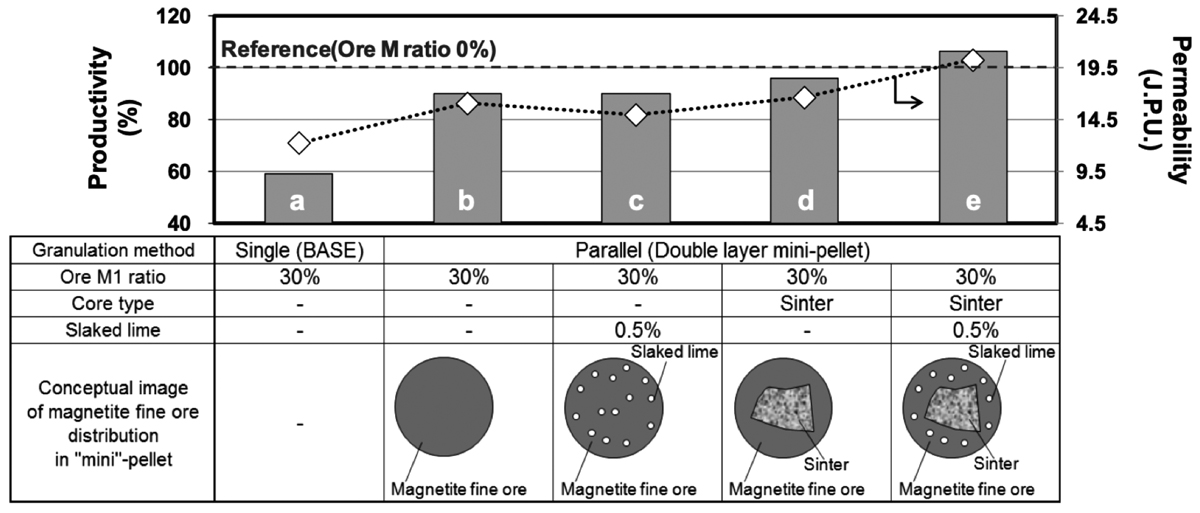 View full abstractDownload PDF (4314K) Full view HTML
View full abstractDownload PDF (4314K) Full view HTML -
Kenji Murakami, Ryo Watanabe, Emiri Matsuhashi, Ayano Nakamura, Kenta ...2021Volume 107Issue 6 Pages 422-430
Published: 2021
Released on J-STAGE: May 31, 2021
JOURNAL OPEN ACCESS FULL-TEXT HTMLTo reduce the amount of CO2 evolution in iron ore sintering process, it is considered to replace a part of coke and anthracite, which are agglomeration agent, with biomass char. However, it is unclear how the particle size of biomass char and the oxygen concentration affect the combustion rate. The purpose of this study is to measure the combustion rate when PKS (Perm Kernel Shell) char and coke breeze with various particle sizes of 0.15-0.25, 0.6-1, 1-3 mm were combusted at a temperature of 400-800°C under 1-5 vol% of oxygen. The combustion rate in the chemical reaction rate-determining step (low temperature region) was analyzed by the Arrhenius equation. It was found that the apparent activation energy was 110-120 kJ/mol for PKS char and 140-150 kJ/mol for coke breeze independent of oxygen concentration and particle size. On the other hand, the frequency factor decreased with increasing particle size. As a result, the combustion rate decreased slightly with increasing particle size. The combustion rate in the diffusion-controlled step (high temperature region) was analyzed by an equation considering the gas diffusion and the pore structure of carbonaceous material. The proposed equation fitted the measured combustion rate well for particle size of 1-3 mm. However, when the particle size was small, the correction factor must be introduced to the equation of combustion rate. Because the combustion rate of PKS char is high even at low oxygen concentration, it is preferable to place the PKS char in the lower layer of the sintering bed.
 View full abstractDownload PDF (2286K) Full view HTML
View full abstractDownload PDF (2286K) Full view HTML -
Daisuke Maruoka, Tsubasa Shima, Taichi Murakami, Eiki Kasai2021Volume 107Issue 6 Pages 431-438
Published: 2021
Released on J-STAGE: May 31, 2021
JOURNAL OPEN ACCESS FULL-TEXT HTMLIn the sintering process of iron ores, coke breeze is utilized as a main agglomeration agent. Its replacement with iron-bearing materials such as metallic iron scraps and magnetite ore seem to be a promising way to reduce CO2 emissions. When using iron-bearing materials together with coke breeze, however, their oxidation reaction appears to be suppressed, since coke combustion tends to decrease in oxygen partial pressure. Therefore, it is necessary to understand the effect of oxygen pressure on the oxidation behavior of the iron-bearing materials. In this study, the oxidation experiments of metallic iron were carried out under the different oxygen partial pressure.
A thin plate sample of metallic iron was heated up to the holding temperature, 1200°C, under N2 atmosphere. Then, the atmosphere was changed to the oxygen partial pressure of 0.001 - 0.21 atm, which was controlled by using N2 or CO2 gas mixture. Oxidation ratio and the thickness of wustite layer formed through the oxidation of metallic iron follows a parabolic manner under PO2 = 0.21 atm. The thickness of wustite layer decreases after 300 s under PO2 = 0.21 atm, while the thicknesses of magnetite and hematite layers increase. It appears that the rate-controlling step changes when all metallic iron is oxidized to wustite. Under the condition of PO2 = 0.01 atm, only wustite layer is observed and the oxidation proceeds faster in CO2 base than in N2. It implies that O2 consumed by oxidation reaction is quickly supplied by the decomposition reaction of CO2 gas.
 View full abstractDownload PDF (2360K) Full view HTML
View full abstractDownload PDF (2360K) Full view HTML -
Yuki Konno, Daisuke Maruoka, Taichi Murakami, Eiki Kasai2021Volume 107Issue 6 Pages 439-446
Published: 2021
Released on J-STAGE: May 31, 2021
JOURNAL OPEN ACCESS FULL-TEXT HTMLIron ore sintering process occupies approximately 3% of CO2 emission of Japan because a large amount of coke breeze was used as a main agglomeration agent. Therefore, its suppression has been required. One of the promising methods is to replace coke breeze with biomass char and iron-bearing materials. In this study, the effect of the utilization of metallic iron with coke or biomass char (PKS char) as an agglomeration agent on its oxidation behavior was examined by series of experiments using a sintering simulator. The use of PKS char leads to a larger decrease in pressure drop difference of the sintering bed compared to the case using coke. The oxidation rate of metallic iron was larger in the case using PKS together than that using coke. It was considered that the oxidation of metallic iron was promoted because the bed-temperature was increased faster and higher in the former case.
 View full abstractDownload PDF (6548K) Full view HTML
View full abstractDownload PDF (6548K) Full view HTML -
Kenichi Higuchi, Jun Okazaki, Seiji Nomura2021Volume 107Issue 6 Pages 447-455
Published: 2021
Released on J-STAGE: May 31, 2021
JOURNAL OPEN ACCESS FULL-TEXT HTMLThe strength of sintered ores is an important property affecting to the permeability of the ore layers of the blast furnace. Since the granulated ores have a composite structure with coarse ores coated by fine ores, melting behavior of those ores is complex including a stepwise melting during sintering. Therefore, it is difficult to predict precisely the strength of sintered ores particularly in the case of ore mixtures consisting with many types of ores. Hence, a prediction method for the strength of sintered ores obtained by mixing several types of ores was investigated. By assuming stepwise melt formation process, two different experimental techniques were adopted to individually evaluate the melting behaviors. The strengthening characteristics of fine ores were effectively expressed by the penetrating length. The penetrating length was reflected by the melt fluidity during heating and depended on the quantity of gangue minerals and combined water, as well as the initial grain size of the ores. In contrast, the strength of sintered coarse ores was expressed by the total porosity after melting with limestone. The total porosity depended on the quantity of combined water and types of gangue minerals. As the governing factors in the melt formation of fine ores and coarse ores were different, the quantitative indices of them were estimated individually and re-combined as the sinter strength index to predict the characteristics of the whole ores mixtures. Results of pot tests revealed that the index correlated well with the measured strength of sintered ores.
 View full abstractDownload PDF (6706K) Full view HTML
View full abstractDownload PDF (6706K) Full view HTML -
Ziming Wang, Takayuki Maeda, Ko-ichiro Ohno, Kazuya Kunitomo2021Volume 107Issue 6 Pages 456-462
Published: 2021
Released on J-STAGE: May 31, 2021
JOURNAL OPEN ACCESS FULL-TEXT HTMLMineral phase formation behavior in the sintering process is one of the most important factors for quality and productivity of iron ore sinter. As resource of high-grade hematite ore is exhausting, it is expected that hematite ore can replaced by magnetite in ironmaking. So that, the purpose of this study is to investigate the effect of magnetite on mineral phase formation. To clarify the effects of magnetite on mineral phases formation, sintering experiments using hematite and magnetite reagent were carried out. To research the effects of atmosphere and temperature, samples were sintered under oxidizing (air) and reducing (CO-CO2) atmosphere at 1250ºC and 1350ºC respectively. The results were analyzed by microscopic observation and image processing. Under both oxidizing and reducing atmosphere, the shapes of each phase after sintering of magnetite samples are likely to hematite samples. From the image processing results, the ratio of each phases formed after sintering of samples were at the same level. So, it is expected that magnetite can be used as raw material instead of hematite in sintering process. Under Air atmosphere, both hematite and magnetite samples formed more calcium ferrite phase when the sintering temperature was higher. Moreover, under Air atmosphere, the calcium ferrite formation ratio of both hematite and magnetite samples was larger than that of under CO-CO2 atmosphere. Therefore, it is very important to keep oxidation state in sintering process.
 View full abstractDownload PDF (2113K) Full view HTML
View full abstractDownload PDF (2113K) Full view HTML -
Taichi Murakami, Shuya Nakamura, Daisuke Maruoka, Eiki Kasai2021Volume 107Issue 6 Pages 463-470
Published: 2021
Released on J-STAGE: May 31, 2021
Advance online publication: November 18, 2020JOURNAL OPEN ACCESS FULL-TEXT HTMLDepletion of high-grade iron ore resources leads to increasing use of ore concentrates as raw materials for sinter. One of the methods to effectively utilize such concentrates is Mosaic EmBedding Iron Ore Sintering (MEBIOS), which pre-granulated green pellets are charged into sintering bed with the mixture of other raw materials. In this study, effects of the ore type and gangue mineral components on the strength of sintered pellet prepared of fine concentrates were examined. Green pellets were prepared using hematite and magnetite ores, burnt lime and alumina and mullite reagents, and then sintered at 1300°C. The strength of sintered pellet increases with increasing basicity (CaO/SiO2, C/S) at lower basicity region. The pellet using hematite ore with C/S above 1.5 showed higher strength than 980 N. It can be attributed to the melt formation during sintering. On the other hand, when using magnetite ore, higher strength than 980 N was obtained above C/S = 1.0. The reason is an acceleration of solid-state sintering by the volume expansion due to oxidation of magnetite to hematite. Increasing Al2O3 content leads to decreasing the strength of pellet because oxidation of magnetite is prevented by the increasing amount of formed melt.
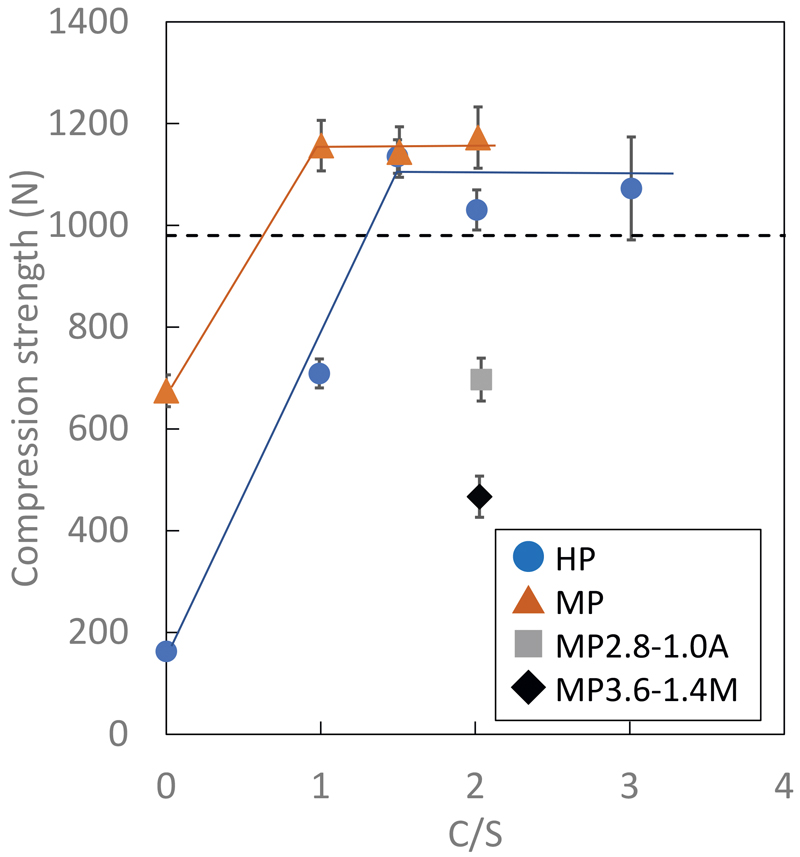 View full abstractDownload PDF (9912K) Full view HTML
View full abstractDownload PDF (9912K) Full view HTML -
Masaru Matsumura, Yasuhide Yamaguchi, Kenichi Higuchi, Taichi Murakami ...2021Volume 107Issue 6 Pages 471-482
Published: 2021
Released on J-STAGE: May 31, 2021
JOURNAL OPEN ACCESS FULL-TEXT HTMLIn order to blend PF (pellet feed) or concentrates for 20 mass% in sinter mixture and to displace coke fines or anthracite to biomass for 25 mass% in BAR (Bonding Agent Rate), sinter packed bed has been designed in ISIJ Research workshop. Outline of the design is shown as below.
As designing, most important factor is permeability, and it has to be maintained even though fine materials as PF or concentrates is highly blended (20 mass%). For high permeability, GP [Green Pellet] granulated from fine materials, is placed in lower layer of raw materials packed bed. In the lower layer, mill scale and biomass char, which has characteristic of different oxidation or combustion temperature and rate compared to coke fine, are placed with coke fines for keeping high temperature (>1200°C), because GP needs longer sintering time due to large diameter. In addition, chemical composition of GP is low bacisity (1.5) and low CaO content for keeping its shape through restricting melt formation at sintering. Restricting melt formation has possibility of improving sinter quality (RI, RDI).
In this study, Effect of the packed bed mentioned above on sinter performance and quality has been confirmed by sintering simulator which has performance of continuous charging and igniting with moving pallet car.
The main results are shown as below.
1) Sintering speed and product yield are maintained at blending 20 mass% of PF. So, sinter productivity are also maintained.
2) Sinter reducibility (RI) has been improved in addition to maintaining sinter reduction disintegration index (RDI) because of low FeO and low SiO2 content and restricting secondary hematite formation as mineral of sinter.
3) Remaining object is recovering sinter strength (TI) at the condition of low CaO content in sinter.
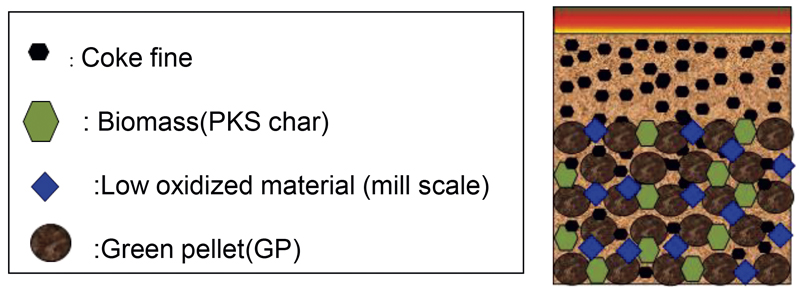 View full abstractDownload PDF (11412K) Full view HTML
View full abstractDownload PDF (11412K) Full view HTML -
Kazumi Iwase, Takahide Higuchi, Tetsuya Yamamoto, Taichi Murakami2021Volume 107Issue 6 Pages 483-493
Published: 2021
Released on J-STAGE: May 31, 2021
JOURNAL OPEN ACCESS FULL-TEXT HTMLCurrent global demand for the carbon emission reduction and the depletion progress of high-grade iron ore deposits require the integrated solution toward sinter and ironmaking process. Several countermeasures have been proposed regarding the development of highly reducible burden materials for the blast furnace and the use of beneficiated fine iron ores in the sintering machine. However, their application to actual sintering and ironmaking equipment have been limited because the sinter productivity is deteriorated. Here the present study investigated co-production of the carbon composite pellet and sinter with existing sintering machines. Even if fired in an oxidizing atmosphere, carbon-core-pellets can be produced under conditions that simulate the conventional sintering process. This is because a protective shell over the carbon core inhibits the carbon from combustion. Importantly, the structure and composition of the pellets are properly designed so that this protective shell does not melt overly or break during firing. The design parameters govern the strength and reducibility of pellets after firing, and those influence is analyzed quantitatively. Overall, a pot test trial in which designed pellets have been blended exhibited the viability of the pellet-sinter co-production.
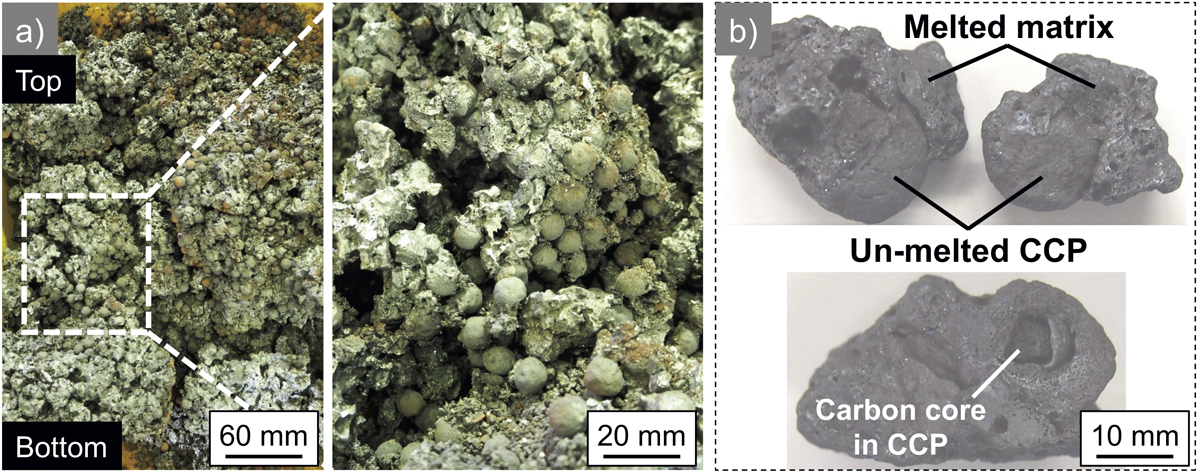 View full abstractDownload PDF (4571K) Full view HTML
View full abstractDownload PDF (4571K) Full view HTML -
Kenji Taira, Kyosuke Hara2021Volume 107Issue 6 Pages 494-501
Published: 2021
Released on J-STAGE: May 31, 2021
Advance online publication: September 11, 2020JOURNAL OPEN ACCESS FULL-TEXT HTMLFor achieving high sinter yield and quality, various technologies are being implemented and developed to control the heat pattern during the sintering reaction. Further improvements in these technologies necessitate detailed time-course profiles of temperature at all sinter-bed heights; however, no technique has yet been reported for determining the temperature distribution in the top layers of the sinter bed at high spatial and time resolutions. Herein, detailed heat patterns in these layers were visualized by a newly developed pot test apparatus having ~300-mm sinter-bed height. The developed apparatus demonstrated the effect of ignition time on heat patterns during combustion and immediately after ignition. Ignition times of 30, 60, and 90 s demonstrated that the high-temperature holding time increased with an increase in ignition time, and this effect is more evident in the top layer. All parameters, including high-temperature holding time, flue gas composition, and sinter yield, suggest that a longer ignition time intensified coke combustion in the top half layer. The developed technique to measure the temperature in the top layer will quantitatively clarify the effect of segregation or ignition condition on the heat pattern in the top layer.
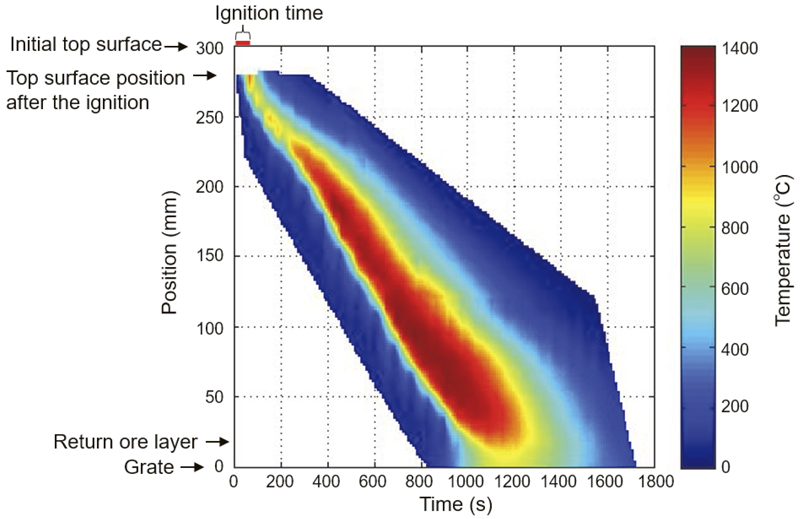 View full abstractDownload PDF (2153K) Full view HTML
View full abstractDownload PDF (2153K) Full view HTML -
Kyosuke Hara, Masaru Matsumura, Kenichi Higuchi2021Volume 107Issue 6 Pages 502-508
Published: 2021
Released on J-STAGE: May 31, 2021
JOURNAL OPEN ACCESS FULL-TEXT HTMLIncreasing sinter productivity, product yield, and sinter strength are important for more efficient processes. Because the sintering bed structure should strongly affect such sintering performances, evaluation techniques and controlling methods have been studied. X-ray computed tomography (CT) was used in several studies, because a sintering bed can be observed without destroying it. Sintering bed shrinkage has been also focused on as an index of product yield or sinter strength, because shrinkage should indicate structural change of the sintering bed. However, shrinkage was only evaluated as a cumulative value at the end of sintering, and material behaviour in the sintering bed has not been clarified. In this study, the correlation of shrinkage and sintering bed structure by X-ray CT observation was investigated. Tracers were located in the sintering bed, and the vertical shrinkage distribution was derived from their height change. The result was compared with the shrinkage change with time. Several factors for shrinkage were considered, and their influence degree was discussed. The main factor was sintering with melt formation. This result, however, contradicted the positive effect of ‘stand’, which prevents shrinkage and improves productivity and product yield. The reason is discussed, focusing on the support effect of the stand and difference in shrinkage distribution in the sintering bed. A quench test at a certain time during sintering was also carried out, and the transition state from granule to sinter was evaluated.
 View full abstractDownload PDF (2179K) Full view HTML
View full abstractDownload PDF (2179K) Full view HTML -
Miyuki Hayashi, Kazuki Morimoto, Hiroki Yamaguchi, Takashi Watanabe, C ...2021Volume 107Issue 6 Pages 509-516
Published: 2021
Released on J-STAGE: May 31, 2021
Advance online publication: February 27, 2021JOURNAL OPEN ACCESS FULL-TEXT HTMLThe formation of acicular silico-ferrite of calcium and aluminum (SFCA) with fine pores has been investigated from the perspectives of sintering temperature, cooling rate and Al2O3 concentration. Two types of hematite iron ore, lime stone, burnt lime and reagent grade Al2O3 powders were mixed so that the Al2O3 concentration was 0.8 mass% and 2 mass%. The mixed powders were uniaxially pressed into a shape of tablet, which was subjected to sintering. Both samples with low and high Al2O3 concentrations (LA and HA samples, respectively) were sintered for 10 min at constant temperatures in the range between 1215ºC and 1325ºC, and then cooled down in air. For LA samples sintered at 1255ºC, the effect of cooling rate (5ºC/min, 50ºC/min and 350ºC/min) was also examined. The samples after sintering were characterized by XRD and EPMA. XRD profiles indicated that only hematite and acicular SFCA existed above 1240ºC for LA sample and above 1230ºC for HA sample. For LA sample, in addition, EMPA indicated:
(i) the acicular SFCA melted above 1305ºC, and probably recrystallized from slag melt during the cooling cycle. The melting temperature increased with additions of Al2O3.
(ii) the fraction of fine pores except macro pores in the sinter increased with decreasing sintering temperature and decreasing cooling rate.
Hence, it is concluded that sintering at lower temperatures, more moderate cooling and higher Al2O3 concentration provide conditions suitable for formation of acicular SFCA with fine pores.
 View full abstractDownload PDF (2595K) Full view HTML
View full abstractDownload PDF (2595K) Full view HTML -
Reiko Murao, Masao Kimura2021Volume 107Issue 6 Pages 517-526
Published: 2021
Released on J-STAGE: May 31, 2021
Advance online publication: December 19, 2020JOURNAL OPEN ACCESS FULL-TEXT HTMLReduction behavior of various multi-component calcium ferrites at 900°C were investigated by using in situ X-ray diffraction (XRD) and X-ray absorption spectroscopy. Intermediate components were determined by XRD, and change in X-ray absorption spectra of Fe and Ca K-edges were analyzed to determine reaction rate constants. SFCA-I (Ca3(Ca,Fe)(Fe,Al)16O28) and SFCA (Ca2(Fe,Ca)6(Fe,Al,Si)6O20) consist of layered structure of spinel and pyroxene. Early stage of reduction reaction, diffraction peaks of spinel structure were observed which indicating SFCA-I and SFCA decomposed into these units at the first step of the reduction reactions. The spinel was reduced sequentially into FeOx then Fe. Intermediate component, Ca2(Fe,Al)2O5 originated in pyroxene module was hard to reduce and reaction was controlled by decomposition of this phase. Reduction of SFCA-I started later than SFCA (with 5.7 mol% Al2O3) under hydrogen gas reduction condition at 900°C. SFCA with a high aluminum content indicated lower reducibility than that with a low one.
 View full abstractDownload PDF (7766K) Full view HTML
View full abstractDownload PDF (7766K) Full view HTML -
Nobuhiro Maruoka, Hironari Kubo2021Volume 107Issue 6 Pages 527-533
Published: 2021
Released on J-STAGE: May 31, 2021
Advance online publication: January 21, 2021JOURNAL OPEN ACCESS FULL-TEXT HTMLIt is necessary to develop an innovative iron-making technology for low-grade iron ore containing a high concentration of P. In this study, we propose a new process for enriching phosphorus in the C2S phase by mixing high-P iron ore, CaO, and graphite in appropriate proportions and partially reducing it. In this study, high-P iron ore adjusted to various basicities and reducing agent ratios was heated at 1573 K in Ar atmosphere, and the obtained sample was analyzed by EPMA. The results showed that in the reduced sample obtained under the conditions of C/S = 2.0 and Target FetO = 60%, more than 95% of P was distributed to the C2S phase, and the P content in metallic iron was sufficiently low.
 View full abstractDownload PDF (2960K) Full view HTML
View full abstractDownload PDF (2960K) Full view HTML -
Noriko Obara, Reiko Murao, Kozo Shinoda, Shigeru Suzuki2021Volume 107Issue 6 Pages 534-541
Published: 2021
Released on J-STAGE: May 31, 2021
JOURNAL OPEN ACCESS FULL-TEXT HTMLThis paper provides a view of formation pathways of various iron oxides, such as hematite, goethite, lepidocrocite, magnetite etc. via aqueous solution. Formation mechanisms of these iron oxides are important to understand formation processes of iron-relevant minerals in Precambrian banded iron formations (BIF). This is because most of iron ores used in Japanese steel industries are imported from BIFs of Australia, Brazil and so on. The chemical and physical properties of the iron ores considerably dominate their sintering before iron making. Nevertheless, formation processes of the iron ores are still enigmatic, since the iron oxide species are changed by a number of reaction conditions.
Various analytical techniques have been used to elucidate oxidation and reduction of the iron oxides in solution from the viewpoint of electrochemical reaction in aqueous solution so far. In those investigations, structural stability of the iron oxides has been studied using the electrochemical potential and pH diagrams of solution. In this paper, formation processes of the iron oxides are discussed as related to the iron ore formation. It is stressed that structural changes of iron oxides including green rusts and oxyhydroxides play an important role in most of iron ore formation.
 View full abstractDownload PDF (1946K) Full view HTML
View full abstractDownload PDF (1946K) Full view HTML
-
Article type: Erratum
2021Volume 107Issue 6 Pages 542
Published: 2021
Released on J-STAGE: May 31, 2021
JOURNAL OPEN ACCESSDownload PDF (96K)
- |<
- <
- 1
- >
- >|